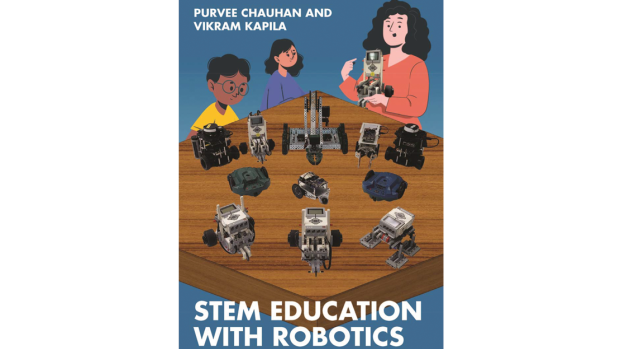A new book authored by NYU Tandon researchers offers guidance on K-12 STEM education

Readers of STEM Education with Robotics: Lessons from Research and Practice, by Purvee Chauhan, a former research associate at NYU Tandon, and NYU Tandon Professor of Mechanical and Aerospace Engineering Vikram Kapila, will find interesting and useful information throughout the book. For example, the very first paragraph of the foreword, written by Professors Punya Mishra and Danah Henriksen of Arizona State University, reveals the origin of the word “robot.” As the tale goes, in the early 20th century, Karel Čapek, a Czech playwright, needed a word to describe a group of factory workers created out of synthetic organic matter and hit upon the idea of using the word roboti, which means “labor” in the Slavic languages; after his play, R.U.R. — which stands for Rossumovi Univerzální Roboti (Rossum’s Universal Robots) premiered in Prague in 1921, the name stuck.
It’s a fascinating piece of trivia, but education researchers, teacher educators, and K12 teachers seeking to understand how to best incorporate robotics into classrooms should read on.
Chauhan and Kapila divide their book into three sections: an Introduction; Theory, Design and Implementation; and Instructional Perspectives and Lesson Designs, with each section containing three chapters. For example, in the introductory section, a chapter on Transformational Learning with Educational Robots, describes how robotics can enable active engagement among students, encourage collaboration with peers, and advance students’ scientific and mathematical aptitude. In the next chapter, Applications of Robots in Educational Settings, the authors present foundational theories, instructional approaches, and ways in which robots can best be used in varied educational settings. The final chapter of the introductory section, Teaching STEM with Robotics: Synopsis of a Research-guided Program, details the structure and results of a multi-year project to create a professional development program for teachers and to plan innovative robotics-based curricula for use by even those educators without a strong STEM background.
Next, in section two, three chapters describe the theoretical foundations that support the authors’ work on curriculum design and teacher professional development. Then, in section three, the final chapters illustrate the alignment between the theory with targeted curriculum and pedagogical aspects. Finally, myriad information concerning surveys, models, lesson templates, and more are provided in two appendices.
Robotics can be an especially motivational learning tool, the authors explain, because the hands-on nature of the field engenders excitement and enthusiasm in students of all ages, and working with construction blocks, sensors, and coding software presents almost limitless opportunities to design, prototype, and explore.
The two warn, however, that it isn’t enough to simply bring robotics kits into the classroom and expect students to benefit. “Effective integration of robotics into learning requires a deep understanding of the varied functionalities of robots in alignment with educational goals,” they assert.
STEM Education with Robotics: Lessons from Research and Practice — which includes numerous ideas for lessons and activities developed during two decades of grant support from NSF programs such as Discovery Research PreK-12 (DRK-12), Graduate STEM Fellows in K-12 Education (GK-12), Innovative Technology Experiences for Students and Teachers (ITEST), and Research Experiences for Teachers (RET) Site — is a good place to start gaining that understanding.

